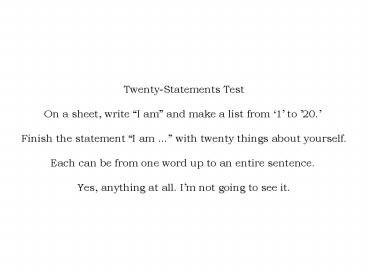TwentyStatements Test - PowerPoint PPT Presentation
1 / 16
Title:
TwentyStatements Test
Description:
Twenty-Statements Test. On a sheet, write 'I am' and make a list from 1' to '20. ... Ted Bundy no conscience, no consideration of others ... – PowerPoint PPT presentation
Number of Views:162
Avg rating:3.0/5.0
Title: TwentyStatements Test
1
Twenty-Statements Test On a sheet, write I am
and make a list from 1 to 20. Finish the
statement I am with twenty things about
yourself. Each can be from one word up to an
entire sentence. Yes, anything at all. Im not
going to see it.
2
- Congratulations you have a self
- (Im willing to bet)
- Do you have views of yourself in social roles?
- Do you have any self-critical views?
- Thats pretty complete.
3
What is it?
- Not consciousness (though thats
importantexamples of Chocolate and Cashew) - Consciousness always look outward not inward
- Alfred Schutz called it the cone of our
attention (like the light from a searchlight or
a flashlight) - It is not our body (though )
4
The self and society
- How are the self and society two sides of the
same coin? - (makes the self pretty important, no?)
5
The self as a process
- Begin with the looking glass self (Cooley)
- Through interaction, we see ourselves through
others eyes - Imagination is important, but so is real
6
The self as process part 2
- The conscious brain, always serving the organism
--- Meads the I. - The image of oneself that develops through
interaction --- Meads the me - The desire for intimacy, contact, approval
- Symbols are important they mediate our
understanding of situations and ourselves
7
Who is important in interaction?
- Significant Others who/what are they?
- The Generalized Other who doesnt even exist!
8
Why/how do we come to accept our SOs standards?
- Chocolate and Cashew dont accept my standards
though they love me! - Mead we practice those standards its how we
internalize them - How? Theres a connection between inner states
and outward expressions - Its why childs playing is so important
practice!
9
Slowthree stages
- Preparatory Stage (many dont mention this as a
stage) - Play Stage
- Game Stage (baseball Mead was a baseball fan in
Chicago)
10
An application crime and incomplete
internalization
- Remember two sides of a coin? Society, then,
needs well-socialized people. - Ted Bundy no conscience, no consideration of
others - In general criminals are considered
incompletely socialized. Example - Michael Gottfredson and Travis Hirschi General
Theory of Crime the common denominator of most
criminals is poor self-control. - Includes short-term time focus, drive for
excitement, lack of concern for others - (Gottfredson Hirschi are among those who dont
like strain theories of deviance)
11
Another Application Inappropriate Socialization
- Edwin Sutherland
- Differential Association
- Who recalls this one?
12
Differential Association
- Issue where do we get our definitions of the
situation that see a deviant/criminal action as
positive or negative? - (hint significant others)
- Sutherland says there are four important aspects
of interaction. They are .
13
Differential Association (cont)
- Aspects of associations with others
- Priority the order in which they occur
- Intensity is this a primary or secondary
- association?
- Frequency How often is there interaction
- Duration How long does the association last?
- (Have I told you about the tiny-dopers?)
14
Question
- What of people who were once considered
inappropriately socialized, but whom we now think
were great? - NOTE Think or people who changed societies.
15
Applications of Socialization Theory
- Crime (specific application)
- Why do some people commit a lot of crimes and
deviant acts? - Why dont more people commit more crimes and
deviant acts? - Symbolic interaction (more general application)
- Herbert Blumer people act toward things based on
the meaning those things have for them these
meanings are derived from social interaction and
modified through interpretation. - We define situations rather than simply
reacting to them. We react differently
depending on the definition. - This affects our interactions themselves.
- The social world is less solid and more in flux,
social reality is temporarily negotiated among
actors.
16
Problems/Issues with Socialization Theory
- Knowledge of self as an object only through
interaction? (e.g., birds and primates) - Biological basis of behavior, versus social
determinism (e.g., the gay gene argument) - Completeness of socialization, versus social
control from outside (atrocities and the thin
veneer of civilization though this is
complicated see My Lai)































